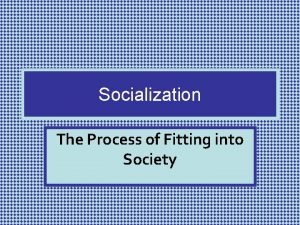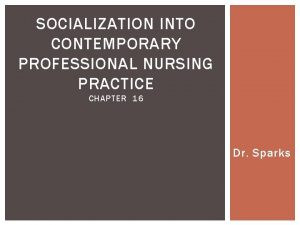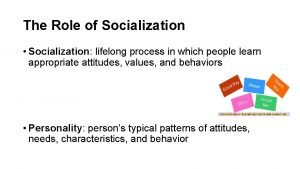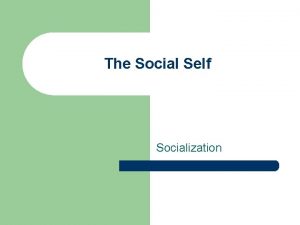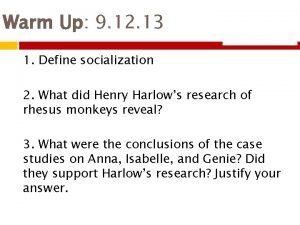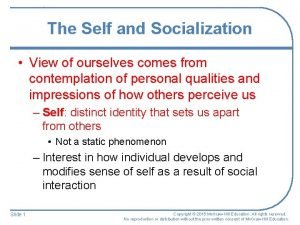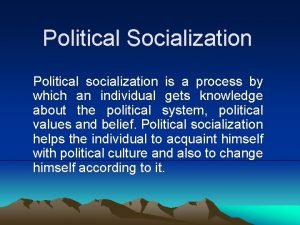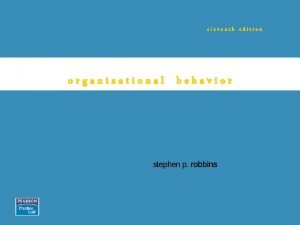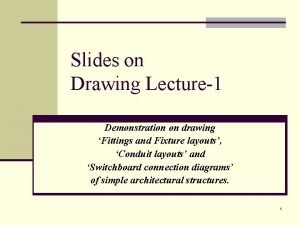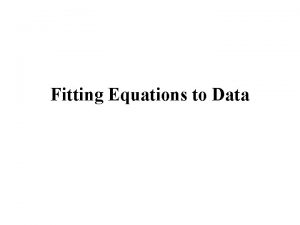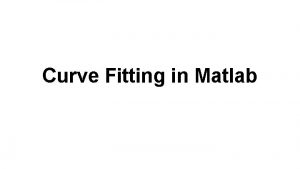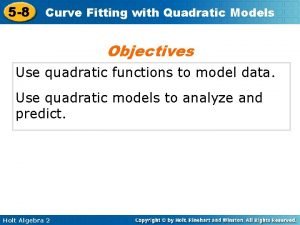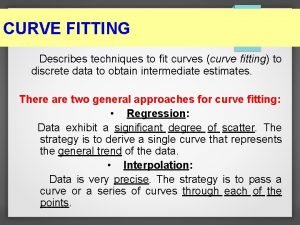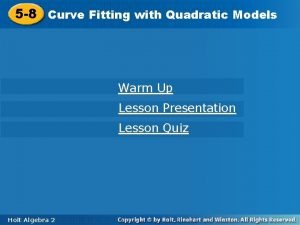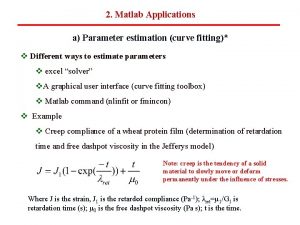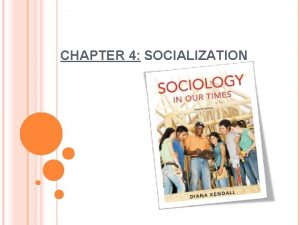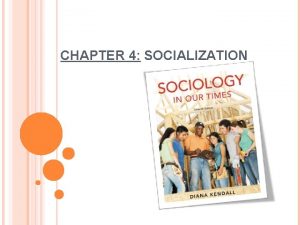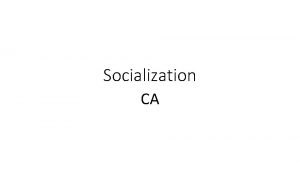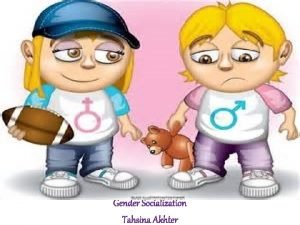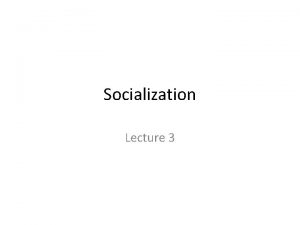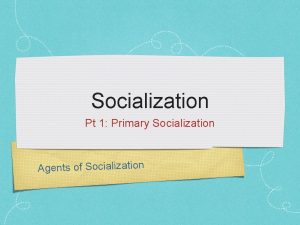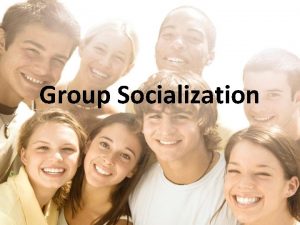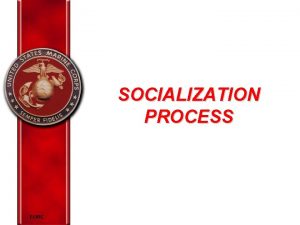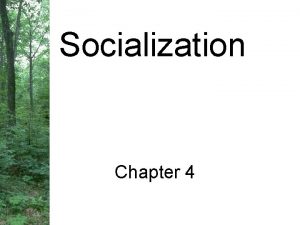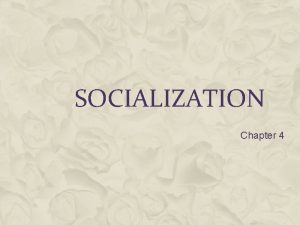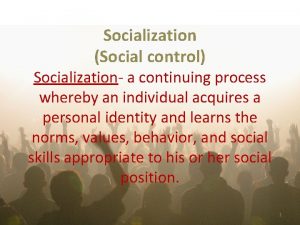CHAPTER 5 SOCIALIZATION The Process of Fitting into





















- Slides: 21

CHAPTER 5: SOCIALIZATION The Process of Fitting into Society

SOCIALIZATION & PERSONALITY Nearly all human social behavior that we think is normal or natural is learned. This learning takes place as soon as we’re born and it continues through our whole life. A baby is NOT born knowing how to behave or feel…they must LEARN it.

SOCIALIZATION & PERSONALITY Socialization is the cultural process of learning to participate in group life. By socialization, we are able to fit into many different social groups. Example: transition from Jr. High to High School. Graduating seniors to the real world.

SOCIALIZATION & PERSONALITY Many believe that if an infant is deprived of prolonged social contact that the child will not be able to develop a set of attitudes, beliefs, values and behaviors that are associated with being an individual.

COOLEY’S LOOKING-GLASS SELF Charles Horton Cooley and George Herbert Mead believe that human nature is a product of society. They use key concepts to explain socialization: self-concept, looking-glass self, significant others, role taking and the generalized other. Your self concept is your image of yourself as having an identity separate from other people. Once someone understands self concept, they are able to themselves on how people will react to them…this is known as the looking-glass self.

COOLEY’S LOOKING-GLASS SELF The looking-glass self is a self concept based on our idea of others’ judgments of us. Cooley believed that we use the analogy of a mirror to see ourselves and try to imagine how people will see us. This happens in 3 stages and they are not done consciously. We imagine how our behaviors will look to others We interpret others’ reactions to our behaviors We develop a self-concept This allows us to figure out if the reaction will be negative or positive.

MEAD’S THEORY ON SOCIALIZATION Mead pointed out that during our lives we’ll come into contact with people who mean more to us than others. These people affect our self concept because we hold them so highly. These people are known as significant others. Examples: mom/dad, teacher, coach, friends, etc. These individuals teach us what is “right” and we mold our self concept based on them!

MEAD’S 3 STAGES OF THE “I-ME” SELF Role taking is when we imagine ourselves through the eyes of another person. We use it in many instances: asking for a raise, asking someone to go on a date, trying to get out of trouble…etc. You try to imagine the conversation and the results that will happen. Examples: job interviews, visit to principal’s office, asking potential bf/gf on a date.

MEAD’S 3 STAGES OF THE “I-ME” SELF Mead believed that role taking was a product of 3 steps: 1. Imitation Stage: This was around 1 -2 ½ years old. We act and behave like a significant other. Example: if mom or dad says a bad word, than the kid repeats it

MEAD’S 3 STAGES OF THE “I-ME” SELF 2. Play Stage Around the ages of 3 -4 years old. The child uses imagination for just about everything. Example: child is an astronaut, a nurse or a firefighter…they take on one role at a time while playing.

MEAD’S 3 STAGES OF THE “I-ME” SELF 3. Game Stage This is around 6+ years old. This is when the child learns how to follow rules in order to do something…like play a card game. This is the stage when they learn about how their behavior will affect their interactions in a group. In the game stage, a person’s self concept begins to form. It is a result of their attitudes, beliefs and values. It mostly comes from the individual itself and not much on pleasing the significant other. They understand what is wrong because it is…not because mom or dad told them it is wrong. When this takes place, the generalized other emerges.

MEAD’S 3 STAGES OF THE “I-ME” SELF Mead believed that the self contained two parts: 1. the “me”: This is created through the socialization process. It relies on conformity and predictability. 2. the “I”: This works with the “me” in social situations. When we first react, we think in terms of “I”, but we channel into what the “me” wants because it is more socially acceptable. Example: the “I” wants to “borrow” a friend’s CD, but the “me” thinks about how the friend will react when they found out who “borrowed” it.

ERIKSON’S 8 STAGES OF DEVELOPMENT Humans develop a personality in 8 different stages. In order to move on to the next stage, one must POSITIVELY master one stage. His theory is based on the assumption that a person develops until the day he/she dies. 8 Stages of Development=pg. 89

JEAN PIAGET’S THEORY OF COGNITIVE DEVELOPMENT Focuses on a person’s ability to think and to reason. Thinking shapes our self concept so it plays a huge role in the socialization process. Theory is based on 4 -stages of development. Studied heavily by individuals wanting to be early education teachers.

JEAN PIAGET’S THEORY OF COGNITIVE DEVELOPMENT Stage 1: sensorimotor Stage 2: preoperational From birth to 2 years Learn world based on senses and motor skills Walking, touching, crawling, putting things into mouth Closer to 2 yrs old…they learn about “object permanence” From 2 yrs-7 yrs Language and vocabulary grow rapidly Kids start to link written words to objects

JEAN PIAGET’S THEORY OF COGNITIVE DEVELOPMENT Stage 3: concrete operational From 7 yrs-12 yrs Start to understand feelings and how others might feel/think Makes connections of objects and things around them Stage 4: formal operational From 12 yrs-above Test their thinking/reasoning, challenging authority Thinks become more abstract…example algebra class

KOHLBERG’S THEORY OF MORAL DEVELOPMENT Revolves around the idea of what is right and wrong Basing his work on Piaget, Kohlberg identifies 3 specific levels: Preconventional Level: birth to elementary school • Moral decisions are based on hedonism Conventional Level: starts around puberty • Basically understands what is “right” and “wrong” based on rules. Postconventional Level: Morality is based on abstract principles that could be rooted in political beliefs, religious beliefs or a combination of both.

CAROL GILLIGAN AND THE “MORALITY OF CARE” Believed that Kohlberg’s theory was biased against women. Gilligan than focused on how gender can influence moral development. Based her theory on two different principles: 1) morality of justice: mostly done by males; rule of law 2)morality of care: mostly done by females: decisions based on how it will effect those in need Research showed that both genders developed morality of justice AND morality of care. Only difference is WHEN.

AGENTS OF SOCIALIZATION The Family • Creates in environments that give unconditional love & support. Provides social control. • 3 different Parenting Styles: Permissive, Authoritative, and Authoritarian Social Class • Socialization is based on social class…raise kids based on expectations assigned to that social class • Opportunities for extra socialization are limited to those in middle- and lower-class families due to fixed incomes. Neighborhoods • Closely tied to social class…where you live says a lot about the opportunities that are available. • Not end all…many from lower-income can rise up and many upper-income and lose it all.

RESOCIALIZATION & TOTAL INSTITUTIONS Must learn new norms, values and behaviors Either voluntary or involuntary One ruleconform or pay the price All activities are pre-planned Done in total institutions All information from outside is monitored Strict hierarchyyou know your place Absolutely NO CHOICE

SOCIALIZATION & THE 3 PERSPECTIVES Symbolic Interactionism • Garfinkel saw total institutions as a way to break down individuals. • Have to break them to build them back up…provide new norms and values based on goals of the total institution. Functionalism Conflict Theory • Utilizes agents of socialization to teach the values at are important to that agent • Religion: Teachings are based on the foundation of the faith. • Education: hidden curriculum not just curriculum set by the State • Believe that society teaches gender roles that can lead to gender bias. • Uses the media to show the “roles” of certain genders are reinforced through shows and movies…do not stray or you stick out.
 Fitting into society
Fitting into society Socialization into professional nursing ati
Socialization into professional nursing ati Nrs 101
Nrs 101 Socialization process
Socialization process Gender socialization is a lifelong process.
Gender socialization is a lifelong process. Self-socialization
Self-socialization Hidden curriculum
Hidden curriculum Socialization process
Socialization process Political socialization is the process by which
Political socialization is the process by which Customer responsive culture example
Customer responsive culture example Lifelong process of social interaction
Lifelong process of social interaction Fitting and fixture layout
Fitting and fixture layout W&w glass systems
W&w glass systems Gaussian curve fitting
Gaussian curve fitting Fitting equations to data
Fitting equations to data Curve fitting matlab
Curve fitting matlab Curve fitting with quadratic models
Curve fitting with quadratic models Matlab sine fitting
Matlab sine fitting Exponential and logarithmic models
Exponential and logarithmic models Curve fitting techniques
Curve fitting techniques Curve fitting with quadratic models
Curve fitting with quadratic models Matlab curve fitting
Matlab curve fitting
